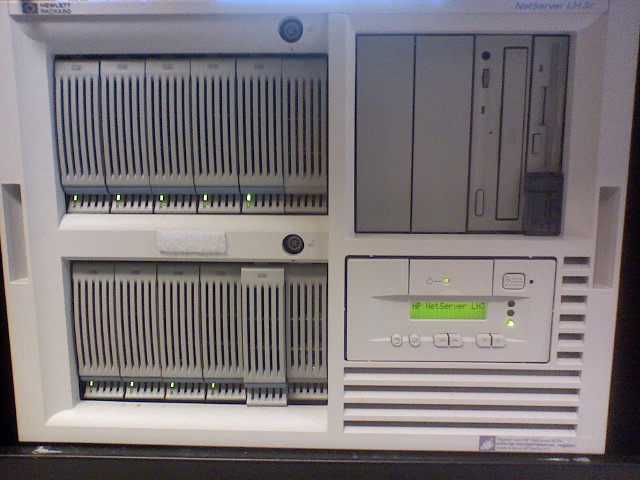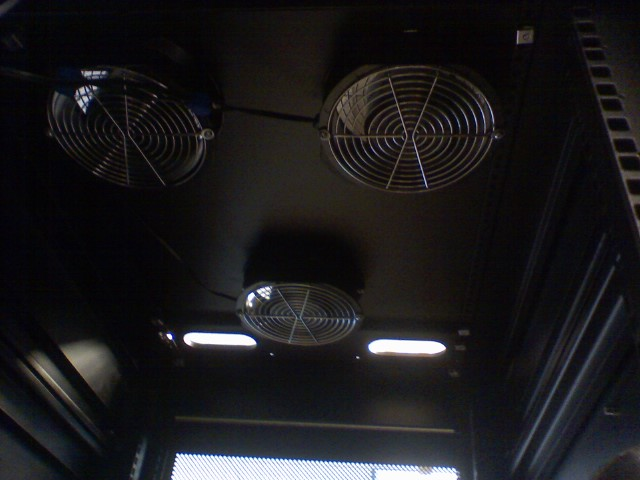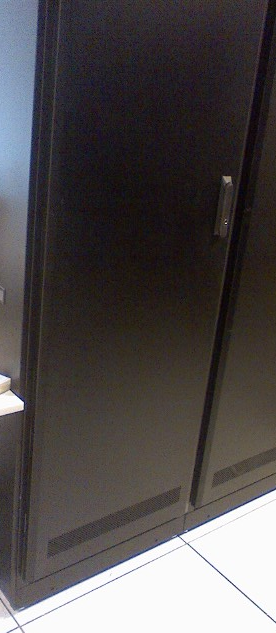As I've mentioned several times here, our data-center was designed and built in the 1999-2000 time frame. Before then, Technical Services had offices in Bond Hall up on campus. The University decided to move certain departments that had zero to very little direct student contact off of campus as a space-saving measure. Technical Service was one of those departments. As were Administrative Computing Services, Human Resources, Telecom, and Purchasing.
At that time, all of our stuff was in the Bond Hall data-center and switching room. This predates me (December 2003), so I may be wrong on some of this stuff. That's a tiny area, and the opportunity to design a brand new data-center from scratch was a delightful one for those who were here to partake of it.
At the time, our standard server was, if I've got the history right, the HP LH3. Like this:

This beast is 7U's high. We were in the process of replacing them with HP ML530's, another 7U server, when the data-center move came, but I'm getting a bit ahead of myself. This means that the data-center was planned with 7U servers in mind. Not the 1-4U rack-dense servers that were very common at that time.
Because the 2U flat-panel monitor and keyboard drawers for rack-dense racks were so expensive, we decided to use plain old 15-17" CRTs and keyboard drawers in the racks themselves. These take up 14U. But that's not a problem!
A 42U rack can take 4x of those 7U servers, and one of the 14U monitor/keyboard combinations for a total of...42U! A perfect fit! The Sun side of the house had their own servers, but I don't know anything about those. With four servers per rack, we put in a Belkin 4-port PS-2 KVM switch (USB was still too new fangled in this era, our servers didn't really have USB ports in them yet) in each. As I said, a perfect fit.
And since we could plan our very own room, we planned for expansion! A big room. With lots of power overhead. And a generator. And a hot/cold aisle setup.
Unfortunately... the designers of the room decided to use a bottom-to-top venting strategy for the heat. With roof mounted rack fans.

And... solid back doors.

We got away with this because only HAD four servers per rack, and those servers were dual processor 1GHz servers. So we only had 8 cores running in the entire rack. This thermal environment worked just fine. I think each rack probably drew no more than 2KW, if that much.
If you know anything about data-center air-flow, you know where our problems showed up when we moved to rack-dense servers in 2004-8 (and a blade rack). We've managed to get some fully vented doors in there to help encourage a more front-to-back airflow. We've also put some air-dams on top of the racks to discourage over-the-top recirculation.
And picked up blanking panels. When we had 4 monster servers per rack we didn't need blanking panels. Now that we're mostly on 1U servers, we really need blanking panels. Plus a cunning use of plexi-glass to provide a clear blanking panel for the CRTs still in the racks.
And now, we have a major, major budget crunch. We had to fight to get the fully perforated doors, and that was back when we had money. Now we don't have money, and still need to improve things. We're not baking servers right now, but temperatures are such that we can't raise the temp in the data-center very much to save on cooling costs. Doing that will require spending some money, and that's very hard right now.
Happily, rack-dense servers and ESX have allowed us to consolidate down to a lot fewer racks, where we can concentrate our good cooling design. Those are hot racks, but at least they aren't baking themselves like they would with the original kit.
At that time, all of our stuff was in the Bond Hall data-center and switching room. This predates me (December 2003), so I may be wrong on some of this stuff. That's a tiny area, and the opportunity to design a brand new data-center from scratch was a delightful one for those who were here to partake of it.
At the time, our standard server was, if I've got the history right, the HP LH3. Like this:

This beast is 7U's high. We were in the process of replacing them with HP ML530's, another 7U server, when the data-center move came, but I'm getting a bit ahead of myself. This means that the data-center was planned with 7U servers in mind. Not the 1-4U rack-dense servers that were very common at that time.
Because the 2U flat-panel monitor and keyboard drawers for rack-dense racks were so expensive, we decided to use plain old 15-17" CRTs and keyboard drawers in the racks themselves. These take up 14U. But that's not a problem!
A 42U rack can take 4x of those 7U servers, and one of the 14U monitor/keyboard combinations for a total of...42U! A perfect fit! The Sun side of the house had their own servers, but I don't know anything about those. With four servers per rack, we put in a Belkin 4-port PS-2 KVM switch (USB was still too new fangled in this era, our servers didn't really have USB ports in them yet) in each. As I said, a perfect fit.
And since we could plan our very own room, we planned for expansion! A big room. With lots of power overhead. And a generator. And a hot/cold aisle setup.
Unfortunately... the designers of the room decided to use a bottom-to-top venting strategy for the heat. With roof mounted rack fans.

And... solid back doors.

We got away with this because only HAD four servers per rack, and those servers were dual processor 1GHz servers. So we only had 8 cores running in the entire rack. This thermal environment worked just fine. I think each rack probably drew no more than 2KW, if that much.
If you know anything about data-center air-flow, you know where our problems showed up when we moved to rack-dense servers in 2004-8 (and a blade rack). We've managed to get some fully vented doors in there to help encourage a more front-to-back airflow. We've also put some air-dams on top of the racks to discourage over-the-top recirculation.
And picked up blanking panels. When we had 4 monster servers per rack we didn't need blanking panels. Now that we're mostly on 1U servers, we really need blanking panels. Plus a cunning use of plexi-glass to provide a clear blanking panel for the CRTs still in the racks.
And now, we have a major, major budget crunch. We had to fight to get the fully perforated doors, and that was back when we had money. Now we don't have money, and still need to improve things. We're not baking servers right now, but temperatures are such that we can't raise the temp in the data-center very much to save on cooling costs. Doing that will require spending some money, and that's very hard right now.
Happily, rack-dense servers and ESX have allowed us to consolidate down to a lot fewer racks, where we can concentrate our good cooling design. Those are hot racks, but at least they aren't baking themselves like they would with the original kit.